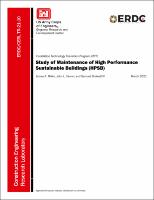Please use this identifier to cite or link to this item:
https://hdl.handle.net/11681/40080Full metadata record
| DC Field | Value | Language |
|---|---|---|
| dc.contributor.author | Miller, James P. | - |
| dc.contributor.author | Vavrin, John L. | - |
| dc.contributor.author | Stidwell IV, Samuel | - |
| dc.date.accessioned | 2021-03-25T17:03:02Z | - |
| dc.date.available | 2021-03-25T17:03:02Z | - |
| dc.date.issued | 2021-03 | - |
| dc.identifier.govdoc | ERDC/CERL TR-21-10 | - |
| dc.identifier.uri | https://hdl.handle.net/11681/40080 | - |
| dc.identifier.uri | http://dx.doi.org/10.21079/11681/40080 | - |
| dc.description | Technical Report | - |
| dc.description.abstract | A study was performed by the Energy Branch of the US Army Engineer Research and Development Center, Construction Engineering Research Laboratory, on behalf of the US Army Installation Management Command under the Installation Technology Transition Program. The focus of the study was related to maintainability and operability issues associated with High Performance Sustainable Buildings (HPSBs). This study was conducted primarily based on information gleaned from telephone and web conference discussions with installation Directorate of Public Works personnel including Operation and Maintenance (O&M) Chiefs, energy managers, maintenance supervisors, and maintenance technicians. Experiences with HPSBs varied from installation to installation. For example, some installations had very positive experiences with photovoltaic (PV) arrays while other sites questioned their practicality due to maintainability problems. One site noted that PV technologies are changing so rapidly that procuring spare/repair parts becomes difficult or impossible when vendors discontinue supporting their older technologies or manufacturers go out of business. Based on discussions with the installation O&M personnel, a table of pro and con recommendations for 25 technologies, which are commonly implemented on HPSBs, was prepared and is included in this report. | en_US |
| dc.description.sponsorship | United States. Army. Installation Management Command. | en_US |
| dc.description.tableofcontents | Abstract .................................................................................................................................... ii Figures and Tables ................................................................................................................... v Preface ..................................................................................................................................... vi Executive Summary ............................................................................................................... vii 1 Introduction ...................................................................................................................... 1 1.1 Background ........................................................................................................ 1 1.2 Objective............................................................................................................. 1 1.3 Approach ............................................................................................................ 1 1.4 Scope .................................................................................................................. 2 2 Observations and Input Data .......................................................................................... 3 2.1 Problematic systems ......................................................................................... 3 2.1.1 Proprietary systems .................................................................................................... 3 2.1.2 Rapid technology obsolescence ................................................................................. 3 2.1.3 Unnecessarily complex systems ................................................................................ 4 2.2 Best practices and recommendations ............................................................. 4 2.3 Conclusion ......................................................................................................... 6 3 Technologies ..................................................................................................................... 8 3.1 Heating, Ventilating, and Air Conditioning (HVAC) Systems ............................ 8 3.1.1 Dedicated Outdoor Air Systems (DOAS) .................................................................... 8 3.1.2 Demand controlled ventilation (DCV) systems ........................................................ 10 3.1.3 Building pressurization controls ............................................................................... 10 3.1.4 Variable refrigerant flow (VRF)systems .................................................................... 10 3.2 Chilled beam systems .................................................................................... 12 3.3 Heating systems ............................................................................................. 13 3.4 Renewable energy systems ............................................................................ 13 3.4.1 Solar domestic hot water (DHW) systems ............................................................... 13 3.4.2 Photovoltaic (PV) systems ......................................................................................... 15 3.4.3 Wind turbine generation systems ............................................................................ 15 3.4.4 Ground source heat pump (GSHP) systems ............................................................ 16 3.5 Lighting control systems.................................................................................. 17 3.6 Fire alarm systems ......................................................................................... 20 3.7 Piping and plumbing systems ......................................................................... 21 3.7.1 Piping materials ........................................................................................................ 21 3.7.2 Touch-free lavatory faucets ...................................................................................... 23 3.7.3 Filtered water bottle stations.................................................................................... 23 3.7.4 Shower mixing valves................................................................................................ 23 3.7.5 Waterless urinals ...................................................................................................... 24 3.7.6 Water efficient plumbing .......................................................................................... 24 3.7.7 Rainwater reclaim systems ...................................................................................... 24 3.8 Plumbing – general ........................................................................................ 25 3.9 Combined heat and power (CHP) .................................................................. 25 3.10 Building automation systems and utility monitoring and control systems .................................................................................................................... 25 3.11 Building envelopes .................................................................................... 26 4 Operations and Maintenance (O&M) Processes and Procurement ........................ 28 4.1 Customer involvement in planning and design ............................................ 28 4.2 Training and hiring .......................................................................................... 28 4.3 Design issues .................................................................................................. 28 4.4 Construction issues ........................................................................................ 29 4.5 O&M issues ..................................................................................................... 30 4.5.1 Training/skills ............................................................................................................ 30 4.5.2 Overly complex systems............................................................................................ 30 4.5.3 Lack of manufacturer support.................................................................................. 30 4.5.4 Unique spare and repair parts ................................................................................. 30 4.5.5 Buy American Act ...................................................................................................... 31 5 Recommendations and Path Forward ......................................................................... 32 5.1 Planning phase ............................................................................................... 32 5.2 Design phase .................................................................................................. 34 5.3 Construction phase ........................................................................................ 35 5.4 Other possible opportunities ......................................................................... 35 Appendix: Questionnaire ...................................................................................................... 36 References ............................................................................................................................. 41 Acronyms and Abbreviations ............................................................................................... 42 Report Documentation Page | - |
| dc.format.extent | 57 pages / 1.22 MB | - |
| dc.format.medium | - | |
| dc.language.iso | en_US | en_US |
| dc.publisher | Construction Engineering Research Laboratory (U.S.) | en_US |
| dc.publisher | Engineer Research and Development Center (U.S.) | - |
| dc.relation.ispartofseries | Technical Report (Engineer Research and Development Center (U.S.)) ; no. ERDC/CERL TR-21-10 | - |
| dc.rights | Approved for Public Release; Distribution is Unlimited | - |
| dc.source | This Digital Resource was created in Microsoft Word and Adobe Acrobat | - |
| dc.subject | Buildings--Energy conservation | en_US |
| dc.subject | Buildings--Performance | en_US |
| dc.subject | Photovoltaic power systems--Technology | en_US |
| dc.subject | Sustainable buildings--Materials | en_US |
| dc.title | Study of maintenance of High Performance Sustainable Buildings (HPSB) | en_US |
| dc.type | Report | en_US |
| Appears in Collections: | Technical Report | |
Files in This Item:
| File | Description | Size | Format | |
|---|---|---|---|---|
| ERDC-CERL TR-21-10.pdf | 1.22 MB | Adobe PDF |  View/Open |